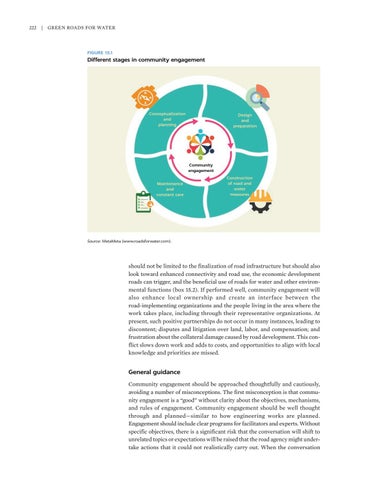222 | Green Roads for Water
FIGURE 15.1
Different stages in community engagement
Conceptualization and planning
Design and preparation
Community engagement Maintenance and constant care
Construction of road and water measures
Source: MetaMeta (www.roadsforwater.com).
should not be limited to the finalization of road infrastructure but should also look toward enhanced connectivity and road use, the economic development roads can trigger, and the beneficial use of roads for water and other environmental functions (box 15.2). If performed well, community engagement will also enhance local ownership and create an interface between the road-implementing organizations and the people living in the area where the work takes place, including through their representative organizations. At present, such positive partnerships do not occur in many instances, leading to discontent; disputes and litigation over land, labor, and compensation; and frustration about the collateral damage caused by road development. This conflict slows down work and adds to costs, and opportunities to align with local knowledge and priorities are missed.
General guidance Community engagement should be approached thoughtfully and cautiously, avoiding a number of misconceptions. The first misconception is that community engagement is a “good” without clarity about the objectives, mechanisms, and rules of engagement. Community engagement should be well thought through and planned—similar to how engineering works are planned. Engagement should include clear programs for facilitators and experts. Without specific objectives, there is a significant risk that the conversation will shift to unrelated topics or expectations will be raised that the road agency might undertake actions that it could not realistically carry out. When the conversation







































